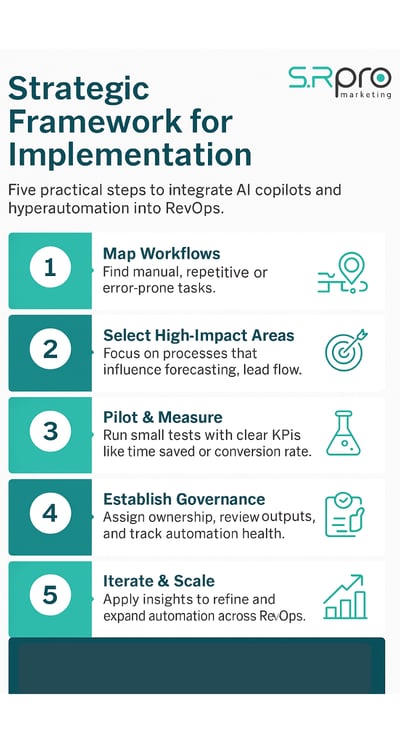
The Role of AI Copilots & Hyperautomation in RevOps Workflows

Revenue Operations (RevOps) has become the frontier of modern go-to-market strategies. It aligns sales, marketing, and customer success to drive scalable and predictable growth. Yet as customer journeys grow more complex and data sources multiply, RevOps teams struggle to turn vast amounts of information into coordinated, revenue-generating action. Growth often begins to outpace existing systems.
AI copilots and hyperautomation are changing that. AI copilots deliver intelligent insights and recommendations that guide decision-making. Hyperautomation ensures those insights are executed quickly and efficiently. Together, they create adaptive systems that improve forecasting, lead management, and overall operational performance.
This article explores how these technologies work, where they add the most value in RevOps, and why human oversight remains vital in the age of intelligent automation.
Defining the Concepts
Before diving into specific applications, it’s important to understand the core technologies shaping modern RevOps. AI copilots and hyperautomation are often mentioned together, but they play distinct yet complementary roles in transforming how revenue teams operate.
Here’s a quick look at what each means and why their convergence matters.
Revenue Operations (RevOps)
RevOps brings together Sales, Marketing, and Customer Success under one strategic framework to eliminate silos and optimize the entire revenue cycle. Its core purpose? Align people, data, and processes to ensure consistent growth and a clear line of sight across the funnel.
AI Copilots
AI copilots act as intelligent assistants within RevOps systems. Instead of performing manual data analysis, teams can rely on AI to surface insights, such as forecast accuracy, lead prioritization, or pipeline health, and even receive data-driven recommendations for next steps. Think of them as decision-support tools that accelerate analysis and improve accuracy.
Hyperautomation
Hyperautomation combines multiple automation technologies, such as robotic process automation (RPA), workflow orchestration, and AI to create systems that handle end-to-end processes with minimal human intervention. In RevOps, this means workflows that not only execute tasks but also adapt based on changing data and business conditions.
Convergence in Action
AI copilots take RevOps to new heights by turning data into intelligent guidance. They analyze patterns, surface insights, and suggest actions in real time, helping teams make smarter, faster decisions.
When combined with hyperautomation, those insights are instantly put into motion. Hyperautomation connects systems, automates workflows, and removes repetitive manual tasks that slow teams down.
Together, AI copilots and hyperautomation create a self-improving RevOps engine. One that learns from every interaction, adapts to changing conditions, and scales seamlessly as the business grows. The result is a faster, more connected revenue process across marketing, sales, and customer success.
Core Use Cases in RevOps Workflows
With the foundations in place, the real impact of AI copilots and hyperautomation becomes clear in day-to-day RevOps operations. Below are key areas where these technologies are already transforming efficiency, accuracy, and decision-making.
- 1. Forecasting & Revenue Intelligence
- Forecasting is at the heart of RevOps. It is also one of its biggest challenges. AI copilots can analyze historical performance, pipeline data, and market trends to generate real-time, scenario-based forecasts. They detect patterns that human analysts might overlook, offering early warnings about pipeline risks.
- Meanwhile, hyperautomation ensures continuous execution. It refreshes data, updates dashboards, and triggers alerts or corrective workflows when anomalies occur. The result is a faster, more accurate view of revenue performance, grounded in live data.
- 2. Lead Qualification & Routing
Traditional lead management is labor-intensive and error-prone. AI copilots streamline this by ranking leads based on behavioral intent, engagement, and fit scores. Once qualified, hyperautomation takes over to handle the next steps. It can automatically assign leads to the right sales reps based on territory, availability, or performance data, ensuring every opportunity lands in the right hands.
It can also trigger personalized nurture sequences or re-score inactive prospects based on engagement signals. This keeps the sales pipeline moving efficiently. Every qualified lead gets timely follow-up, and no opportunity slips through the cracks due to human error or slow response times.
- 3. Adaptive Workflows & Process Orchestration
RevOps processes rarely follow a straight path. Deals stall, customers churn, or market conditions shift. AI copilots can detect these shifts in real time and recommend next-best actions, such as retargeting an account or offering a retention incentive.
Hyperautomation then reconfigures the workflow automatically, allowing the system to adapt seamlessly without the need for manual redesign. Over time, these adaptive processes learn and improve based on priorities and specific conditions, making RevOps more resilient and agile.
Human Oversight in the Age of Automation
AI copilots and hyperautomation can transform RevOps into a faster, smarter, and more scalable system. But no matter how advanced the technology becomes, human oversight is still irreplaceable.
People provide the strategic direction that machines follow. They set priorities, interpret insights, and make judgment calls where data alone can’t tell the full story. Context, empathy, and experience remain critical, especially when decisions affect customers or revenue outcomes.
RevOps leaders serve as the bridge between automation and strategy. They validate AI-generated insights, review anomalies, and decide when human intervention is needed. They also ensure that automated actions stay aligned with broader business goals and ethical standards.
Keeping a “human in the loop” approach doesn’t slow progress, but strengthens it. It helps maintain accuracy, transparency, and compliance while preserving the human intelligence that gives technology its purpose.
Key Enablers & Challenges
For AI copilots and hyperautomation to work effectively, certain foundations must be in place. These are the enablers that keep systems connected and decisions consistent across the organization.
Enablers
- Clean, unified data - Centralized and standardized data across marketing, sales, and customer systems ensures every insight is accurate and actionable.
- Integrated tech stack - Seamless connections between CRMs, analytics tools, and automation platforms enable real-time collaboration and faster execution.
- Connected workflows - When teams share information and automation flows between departments, handoffs become smoother and less error-prone.
- Cross-functional alignment - Shared KPIs keep everyone focused on the same growth outcomes rather than isolated departmental goals.
- Governance and security - Strong data protection and compliance frameworks build trust and stability as automation scales.
Building this foundation, however, isn’t easy. Organizations often face barriers that limit automation’s full potential.
Challenges
- Data silos - Inconsistent or fragmented data leads to poor insights and unreliable automation outcomes.
- Over-automation - Too much automation can remove flexibility and the human touch that customers value.
- Opaque AI models - Lack of visibility into how AI makes decisions can create mistrust or compliance risks.
- Cultural resistance - Teams may hesitate to adopt new tools or workflows if they fear complexity or job disruption.
Overcoming these challenges takes more than technology. It requires strong leadership, continuous learning, and a culture that values experimentation and data-driven improvement. When people, process, and technology evolve together, RevOps becomes not just automated, but intelligently adaptive.
Strategic Framework for Implementation
For RevOps teams looking to integrate AI copilots and hyperautomation, a structured approach ensures smoother adoption and measurable impact. Here’s an infographic that outlines a simple roadmap to get started:

This phased approach helps RevOps teams adopt AI copilots and hyperautomation more effectively. It minimizes risk, builds confidence through gradual adoption, and delivers measurable results from the start.
Future Outlook & Implications
RevOps is moving toward a future where systems support operations and actively think, predict, and improve themselves. The next generation of RevOps will be adaptive, predictive, and self-optimizing, powered by AI copilots and hyperautomation working in sync.
AI copilots will be built directly into CRMs, analytics dashboards, and marketing platforms. They’ll help teams interpret data faster, predict outcomes, and recommend the next best action in real time. Instead of searching for insights, teams will receive context-aware guidance, like which leads are most likely to convert or when to re-engage dormant accounts.
Hyperautomation will serve as the execution layer behind these insights. It will handle repetitive, time-sensitive processes such as updating records, routing leads, or syncing data across systems instantly and without error. This creates a continuous feedback loop where every decision and action improves the system’s performance over time.
But technology alone won’t define the winners. The most successful organizations will balance automation with human judgment. Leaders will still need to interpret context, manage exceptions, and make ethical decisions that machines can’t.
As RevOps becomes increasingly intelligent, the human role shifts from operator to orchestrator, guiding strategy, validating outcomes, and using automation to scale innovation. The future of RevOps isn’t just faster or smarter. It’s more connected, proactive, and insight-driven, built on seamless collaboration between people and intelligent systems.
Conclusion: The Future of RevOps Is Intelligent and Human-Centered
AI copilots and hyperautomation are redefining how RevOps operates. They turn data into action and transform manual processes into intelligent, self-learning workflows. These technologies bring greater speed, accuracy, and scalability to every stage of the revenue engine, from forecasting to customer retention.
Yet the real power lies in how humans use them. With people guiding governance, ethics, and strategy, automation becomes not just efficient but truly intelligent. Organizations that embrace this balance today will gain a measurable advantage in growth, efficiency, and foresight.
As marketing automation experts, we help RevOps teams harness AI and automation to boost performance, efficiency, and smarter campaign execution. Connect with us to see how your organization can scale faster with intelligent, data-driven workflows.
